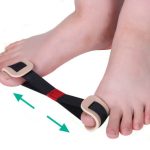A bunion is a bony bump that forms when the bones of your foot shift out of position. These lumps usually form at the base of your big toe.
Bunions can be painful, and they can interfere with walking and other activities. If they don’t improve with conservative treatments, your provider may recommend surgery.
Symptoms
If your bunion is painful, it’s a good idea to see a foot doctor. They can examine your feet, do an X-ray and tell you how serious it is.
A bunion is a bump or enlargement at the base of your big toe that forms when the joint at the base of your toe bends sideways (out of position). It’s not normal for a joint to bend this way.
It happens when there is a problem with the way your foot is made or if you have other health problems that cause the joint to swell and hurt, like rheumatoid arthritis.
Bunions can happen to people of all ages, but they are more common in women 拇趾外翻 than men. They may be hereditary or be caused by wearing shoes that sock your toes together.
Diagnosis
A bunion can be diagnosed by examining your foot and taking an X-ray. This allows your doctor to see how far the joint has moved away from the other toes, and whether any other bones in your foot or toes have been affected.
Some people have a tendency to develop bunions because of an inherited foot defect, but the condition can also be caused by wearing shoes that are too narrow or tight. Other factors, such as being overweight or having a structural problem in your feet, may increase your risk of developing this problem.
Early diagnosis by a doctor is important because it can be treated before the bunion causes pain and discomfort that affects your daily activities. Your doctor will ask questions about your symptoms, when you first noticed the bump, and what kind of shoes you wear.
Mild pain from plenty diet pill reviews a bunion can usually be managed with changes in shoe wear. If these changes aren’t successful, a doctor may recommend orthoses (shoe inserts) or other treatments. Sometimes, a doctor injects a cortisone substance into the inflamed bursa to relieve pain and swelling.
Treatment
If conservative treatments such as changing shoes, applying ice and wearing padded foot inserts do not help reduce your pain, surgery may be required. This procedure can be performed in an outpatient setting or as a part of an overnight stay in the hospital under local, spinal or general anesthesia.
Orthotic devices or pads positioned over the bunion can also help relieve symptoms. However, these should only be used if the shoe fits well and there is adequate space between your big toe and the second toe.
Other treatment options for a bunion include medication, activity modifications and injection therapy. These medications can include over-the-counter or prescription nonsteroidal anti-inflammatory drugs (NSAIDs), such as acetaminophen, ibuprofen and naproxen sodium.
Injections of cortisone into the fluid-filled bursa surrounding your big toe can also reduce inflammation and pain. These are rarely used but can be effective when other treatment options fail.
Prevention
If you are looking to prevent a bunion, there are some important steps you can take. Bunions can be painful and a significant source of discomfort.
Preventing a bunion can be as simple as wearing the right shoes. Choose shoes with a wide toe box and space between your longest toe and the tip of the shoe.
Having good foot mechanics is another vital step in preventing bunion development. Your podiatrist can help you identify and correct any alignment issues that may be putting abnormal pressure on your feet.
Early intervention with custom or off-the-shelf orthotics can slow down the progression of a bunion and prevent it from getting worse. Wearing a soft splint at night to keep the big toe straight can also reduce the likelihood of a bunion recurrence.
Contents
